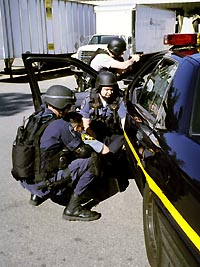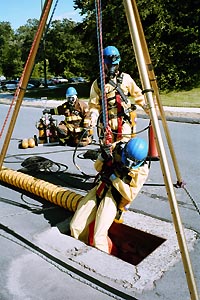|
This is an archived article.
For the latest news, go to the Advance
Homepage
For more archives, go to the Advance Archive/Search Page. |
||||
|
Health
Center's Special Operations Unit
Ready to Respond in Times of Crisis By Jane Shaskan
The Special Operations Unit was able to respond to the crisis at a moment's notice. But the rapid response time owed much to several years of planning and training. After the tragedies that took place in Columbine, Oklahoma City, at the Trade Center in 1993 and, closer to home, the lottery shootings in Newington, Health Center firefighters began to prepare for severe emergencies. "We saw the need for specialized training to create an advanced life support system for the public's safety in what now seemed to be an unpredictable and dangerous world," says Lt. John Kowalski, commanding officer of the Special Operations Unit. "The support system became a high priority, and during the last seven years, we developed and implemented the Special Operations Unit. "Our mission is to provide advanced life support coverage for austere conditions. There is no other fire department in the state, and probably in the Northeast, that has reached the level of training of our firefighters in the Tactical Unit," says Kowalski. "We stand ready if called by the fire departments of any UConn campus or any fire department in need of support." All 20 Health Center firefighters have advanced training, and participate in the Special Operations Unit at some level, based on their training. There are a number of different teams under the umbrella of Special Operations: The Hazmat Unit, led by the team leader Firefighter Fran Brunet, provides technical assistance in hazardous materials incidents, such as industrial accidents, and chemical and radiation attacks, and also in the decontamination of victims. Some of the unit members are also paramedics who can provide medical and toxicological information and treatment. Members of the Technical Rescue Team - firefighters and paramedics - are trained to rescue and provide medical aid to victims of collapsed buildings, or victims trapped in a confined space, such as a sewer drain, or at a high angle, as in a mountain rescue. Paramedics can assess compression injuries, provide emergency paramedical treatment, and assist specially trained Health Center surgeons with surgical procedures. This team is directed by Captain William Perkins. The next level of training involves the Tactical Rescue Team, which is headed by Lt. Ben Sonstrom. Trained by the Department of Defense, this team is ready to respond to shootings, barricade situations, hostage incidents, riots, and bombing incidents, by providing emergency medical aid and, in dire circumstances, judging the medical condition of victims and aggressors through observation. The team has also been trained to provide aid in the case of a biological, chemical, or nuclear terrorist event. It is the advanced training of its Special Operations Units in areas such as toxicology, hazardous materials, live chemical agents, explosives, and nuclear/radiological weapons that sets the UConn Health Center Fire Department apart from others in the state, says Kowalski: "We are the civilian version of military combat medics and train using weapons, but we go in unarmed. The SWAT team clears the way. Our job is to provide advanced life support coverage and sometimes that means protecting those who protect the people." The firefighters "day job?" Their primary responsibility is fire prevention and protection for the Health Center. The Health Center Fire Department responded to about 3,500 emergency calls last year, including assistance to a number of surrounding towns. The department has two fire engines, two advanced life support rescue vehicles, two neonatal intensive care unit transport vans, and a tactical vehicle for special operation support soon to be replaced with a heavy tactical unit. Supported by federal funds, a hazardous materials decontamination trailer is currently under design.
|
 hey were there within 24 hours of the strike on the Twin
Towers, about 100 yards from Ground Zero. In the midst of the
devastation, the Health Center Fire Department's Special
Operations Unit was on hand to assist and provide specialized
medical support to anyone in need of care.
hey were there within 24 hours of the strike on the Twin
Towers, about 100 yards from Ground Zero. In the midst of the
devastation, the Health Center Fire Department's Special
Operations Unit was on hand to assist and provide specialized
medical support to anyone in need of care.

